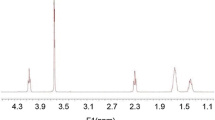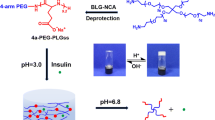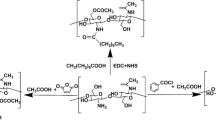Abstract
The hydrolytic and enzymatic degradation of newly developed hydrogels, produced by cross-linking purified poly(γ-glutamic acid) (γPGA) with dihaloalkane compounds, was studied and is reported in this paper. Analysis of hydrolysis of the hydrogel as a function of pH indicated that the hydrolysis occurred slowly at neutral pH, but fast in both acidic and alkaline solutions, while the polymer could be hydrolyzed rapidly only in acidic solutions. The ester bonds were more sensitive to hydrolysis than peptide bonds. The biodegradability of the hydrogel and polymer was further confirmed when enzymatic degradation was studied by three enzymes (cathepsin B, pronase E, and trypsin), which were able to cleave both ester and peptide bonds gradually. A slow-release system for porcine somatotropin (pST) formed by using the hydrogel as matrix to entrap the hormone was evaluatedin vitro andin vivo. Results demonstrated that the hydrogel was able to release the hormone for a period of 20–30 days and indicated its potential application in slow-release systems for bioactive materials, especially macromolecules, such as peptides and proteins.
Similar content being viewed by others
References
A. J. Domb, S. Amselem, and M. Maniar (1994) in S. Dumitriu (Ed.),Polymeric Biomaterials, Marcel Dekker, New York, pp. 399–433.
R. Langer (1990)Science 249 1527–1533.
J. Kohn and P. Sinko (1992) in M. A. El-Nokalyet al. (eds.),Polymeric Delivery Systems: Properties and Application, ACS Symposium Series 520, pp. 18–41.
P. L. Lee and W. R. Good (1987)Controlled-Release Technology, American Chemical Society Symposium Series 348, Washington, DC.
R. Langer and M. Moses (1991)J. Cell. Biochem 43 340–345.
E. Ron, T. Turek, E. Mathiowitz, M. Chasin, M. Hageman, and R. Langer (1993)Proc. Natl. Acad. Sci. USA 90 4176–4180.
C. G. Pitt (1993)Proc. Int. Symp. Control. Rel. Bioact. Mater., Controlled Release Society, Inc., Vol. 20, pp. 146–147.
N. A. Peppas, and L. K. Foster (1994)J. Appl. Polym. Sci. 52 763–768.
K. Park (1993)Polym. Prepr. 34 844–845.
C. B. Thorne, C. G. Gomez, H. E. Noyes, and R. D. Housewright (1954)J. Bacteriol 68 307–315.
J. W. Goodman and D. E. Nitecki (1967)Immunology 13 577–583.
T. G. Blanchard (1991)Investigating the Use of Polyglutamic Acid for Enteric Delivery of Idiotypic Antibodies, Ph.D. dissertation, University of Massachusetts, Amherst.
H. Kubota, Y. Nambu, and T. Endo (1993)J. Polym. Sci. A Polym. Chem. 31 2877–2878.
M. Borbely, Y. Nagasaki, J. Borbely, K. Fan, A. Bhogle, and M. Sevoian (1994)Polym. Bull. 32 127–132.
T. D. Shah, S. P. McCarthy, and R. A. Gross (1992)Polym. Prepr. 33 488–490.
C. M. Evock, T. D. Etherton, C. S. Chung, and R. E. Ivy (1988)J. Anim. Sci. 66 1928–1941.
M. W. A. Verstegen, W. Van del Hel, H. A. Brandsma, A. M. Henken, E. Kanis, and P. Van der Wal (1991)J. Anim. Sci. 69 2961–2970.
S. D. M. Jones, A. L. Schaefer, A. K. W. Tong, W. Robertson, and L. L. Holt (1994)Can. J. Anim. Sci. 74 15–22.
C. G. Leonard, R. D. Housewright, and C. B. Thorne (1958)J. Bacteriol. 76 499–503.
D. Gonzales, K. Fan, and M. Sevoian (1996)J. Polym. Sci. A Polym. Chem. 34.
K. Fan, D. Gonzales, and M. Sevoian (1996) in preparation.
M. D. Groesbeck and A. F. Parlow (1987)Endocrinology 120 2582–2590.
B. L. Buckwalter, S. M. Cady, H. M. Shieh, A. K. Chaudhuri, and D. F. Johnson (1992)J. Agr. Food Chem. 40 356–362.
U. Iizuka, M. Oya, M. Iwatsuki, and T. Hayashi (1993)Polym. J. 25 285–290.
P. Rejmanova, J. Kopecek, J. Pohl, M. Baudys, and V. Kostka (1983)Makromol. Chem. 184 2009–2020.
J. Pytela, V. Saudek, J. Drobnik, and F. Rypacek (1989)J. Control. Release 10 17–25.
C. B. Thorne and C. G. Leonard (1958)J. Biol. Chem. 233 1109–1112.
Author information
Authors and Affiliations
Rights and permissions
About this article
Cite this article
Fan, K., Gonzales, D. & Sevoian, M. Hydrolytic and enzymatic degradation of poly(γ-glutamic acid) hydrogels and their application in slow-release systems for proteins. J Environ Polym Degr 4, 253–260 (1996). https://doi.org/10.1007/BF02070694
Issue Date:
DOI: https://doi.org/10.1007/BF02070694




